Dell PP10S User Manual
Dell™ Inspiron™ 1200 and 2200
Owner’s Manual
Model PP10S
w w w . d e l l . c o m | s u p p o r t . d e l l . c o m

Notes, Notices, and Cautions
NOTE: A NOTE indicates important information that helps you make better use of your computer.
NOTICE: A NOTICE indicates either potential damage to hardware or loss of data and tells you how to avoid the problem.
 CAUTION: A CAUTION indicates a potential for property damage, personal injury, or death.
CAUTION: A CAUTION indicates a potential for property damage, personal injury, or death.
If you purchased a Dell™ n Series computer, any references in this document to Microsoft® Windows® operating systems are not applicable.
Information in this document is subject to change without notice. © 2005 Dell Inc. All rights reserved.
Reproduction in any manner whatsoever without the written permission of Dell Inc. is strictly forbidden.
Trademarks used in this text: Dell, the DELL logo, Inspiron, Dell Precision, Dimension, OptiPlex, Latitude, PowerEdge, PowerVault, PowerApp,
Axim, and DellNet are trademarks of Dell Inc.; Intel, Pentium, and Celeron are registered trademarks of Intel Corporation; Microsoft, MS-DOS, and Windows are registered trademarks of Microsoft Corporation.
Other trademarks and trade names may be used in this document to refer to either the entities claiming the marks and names or their products. Dell Inc. disclaims any proprietary interest in trademarks and trade names other than its own.
Model PP10S
January 2005 |
P/N D8833 |
Rev. A00 |

Contents
Finding Information . . . . . . . . . . . . . . . . . . . . . . . . . . . . . . . . 9
1 About Your Computer
Front View . . . . . . . . . . . . . . . . . . . . . . . . . . . . . . . . . . . . |
13 |
Left Side View . . . . . . . . . . . . . . . . . . . . . . . . . . . . . . . . . . |
16 |
Right Side View . . . . . . . . . . . . . . . . . . . . . . . . . . . . . . . . . |
17 |
Back View . . . . . . . . . . . . . . . . . . . . . . . . . . . . . . . . . . . . |
17 |
Bottom View . . . . . . . . . . . . . . . . . . . . . . . . . . . . . . . . . . . |
20 |
2 Setting Up Your Computer
Connecting to the Internet . . . . . . . . . . . . . . . . . . . . . . . . . . . . |
21 |
Setting Up Your Internet Connection . . . . . . . . . . . . . . . . . . . . |
21 |
Transferring Information to a New Computer . . . . . . . . . . . . . . . . . . |
22 |
Running the Files and Settings Transfer Wizard Without the |
|
Operating System CD . . . . . . . . . . . . . . . . . . . . . . . . . . . . |
23 |
Running the Files and Settings Transfer Wizard With the |
|
Operating System CD . . . . . . . . . . . . . . . . . . . . . . . . . . . . |
24 |
Setting Up a Printer . . . . . . . . . . . . . . . . . . . . . . . . . . . . . . . |
25 |
Printer Cable . . . . . . . . . . . . . . . . . . . . . . . . . . . . . . . . |
25 |
Connecting a USB Printer. . . . . . . . . . . . . . . . . . . . . . . . . . |
25 |
Power Protection Devices . . . . . . . . . . . . . . . . . . . . . . . . . . . . |
26 |
Surge Protectors . . . . . . . . . . . . . . . . . . . . . . . . . . . . . . |
26 |
Line Conditioners . . . . . . . . . . . . . . . . . . . . . . . . . . . . . . |
26 |
Uninterruptible Power Supplies . . . . . . . . . . . . . . . . . . . . . . |
26 |
Contents 3

3 Using a Battery |
|
Battery Performance . . . . . . . . . . . . . . . . . . . . . . . . . . . . . . . |
27 |
Checking the Battery Charge . . . . . . . . . . . . . . . . . . . . . . . . . . |
28 |
Dell QuickSet Battery Meter . . . . . . . . . . . . . . . . . . . . . . . . |
28 |
Low-Battery Warning . . . . . . . . . . . . . . . . . . . . . . . . . . . . |
28 |
Charging the Battery . . . . . . . . . . . . . . . . . . . . . . . . . . . . . . . |
29 |
Removing a Battery . . . . . . . . . . . . . . . . . . . . . . . . . . . . . . . |
29 |
Installing a Battery. . . . . . . . . . . . . . . . . . . . . . . . . . . . . . . . |
30 |
Storing a Battery . . . . . . . . . . . . . . . . . . . . . . . . . . . . . . . . . |
30 |
4 Power Management
Power Management Tips . . . . . . . . . . . . . . . . . . . . . . . . . . . . |
31 |
Power Management Wizard . . . . . . . . . . . . . . . . . . . . . . . . . . . |
31 |
Setting Sleep Modes . . . . . . . . . . . . . . . . . . . . . . . . . . . . |
31 |
Selecting a Power Scheme . . . . . . . . . . . . . . . . . . . . . . . . . |
32 |
Setting Battery Alarms and Actions . . . . . . . . . . . . . . . . . . . . |
33 |
Completing the Power Management Wizard . . . . . . . . . . . . . . . . |
33 |
Power Management Modes . . . . . . . . . . . . . . . . . . . . . . . . . . . |
33 |
Standby Mode . . . . . . . . . . . . . . . . . . . . . . . . . . . . . . . |
33 |
Hibernate Mode. . . . . . . . . . . . . . . . . . . . . . . . . . . . . . . |
34 |
Power Options Properties . . . . . . . . . . . . . . . . . . . . . . . . . . . . |
34 |
Power Schemes Tab . . . . . . . . . . . . . . . . . . . . . . . . . . . . |
34 |
Alarms Tab . . . . . . . . . . . . . . . . . . . . . . . . . . . . . . . . . |
35 |
Power Meter Tab . . . . . . . . . . . . . . . . . . . . . . . . . . . . . . |
35 |
Advanced Tab . . . . . . . . . . . . . . . . . . . . . . . . . . . . . . . . |
35 |
Hibernate Tab . . . . . . . . . . . . . . . . . . . . . . . . . . . . . . . . |
35 |
5 Using CDs, DVDs, and Other Multimedia
Playing a CD or DVD . . . . . . . . . . . . . . . . . . . . . . . . . . . . . . . |
37 |
Adjusting the Volume . . . . . . . . . . . . . . . . . . . . . . . . . . . . . . |
38 |
Adjusting the Picture . . . . . . . . . . . . . . . . . . . . . . . . . . . . . . |
39 |
4 Contents

6 Using the Keyboard and Touch Pad
|
Numeric Keypad . . . . . . . . . . . . . . . . . . . . . . . . . . . . . . . . . |
41 |
|
Key Combinations . . . . . . . . . . . . . . . . . . . . . . . . . . . . . . . . |
42 |
|
System Functions . . . . . . . . . . . . . . . . . . . . . . . . . . . . . . |
42 |
|
Battery . . . . . . . . . . . . . . . . . . . . . . . . . . . . . . . . . . . |
42 |
|
CD or DVD Tray . . . . . . . . . . . . . . . . . . . . . . . . . . . . . . . |
42 |
|
Display Functions . . . . . . . . . . . . . . . . . . . . . . . . . . . . . . |
42 |
|
Radios (Including Wireless Networking) . . . . . . . . . . . . . . . . . . |
42 |
|
Power Management . . . . . . . . . . . . . . . . . . . . . . . . . . . . |
42 |
|
Speaker Functions . . . . . . . . . . . . . . . . . . . . . . . . . . . . . |
43 |
|
Microsoft® Windows® Logo Key Functions . . . . . . . . . . . . . . . . |
43 |
|
Touch Pad . . . . . . . . . . . . . . . . . . . . . . . . . . . . . . . . . . . . |
44 |
|
Customizing the Touch Pad . . . . . . . . . . . . . . . . . . . . . . . . . |
44 |
7 |
Using PC Cards |
|
|
PC Card Types . . . . . . . . . . . . . . . . . . . . . . . . . . . . . . . . . . |
45 |
|
Extended PC Cards . . . . . . . . . . . . . . . . . . . . . . . . . . . . . . . . |
45 |
|
Installing a PC Card . . . . . . . . . . . . . . . . . . . . . . . . . . . . . . . |
45 |
|
Removing a PC Card or Blank . . . . . . . . . . . . . . . . . . . . . . . . . . |
46 |
8 Setting Up a Network |
|
|
|
Connecting to a Network Adapter . . . . . . . . . . . . . . . . . . . . . . . . |
47 |
|
Network Setup Wizard. . . . . . . . . . . . . . . . . . . . . . . . . . . . . . |
47 |
|
Connecting to a Wireless Local Area Network . . . . . . . . . . . . . . . . . |
48 |
|
Determining Your Network Type . . . . . . . . . . . . . . . . . . . . . . |
48 |
|
Connecting to a Wireless Network in Microsoft® Windows® XP . . . . . |
48 |
9 |
Solving Problems |
|
|
Dell Diagnostics . . . . . . . . . . . . . . . . . . . . . . . . . . . . . . . . . |
51 |
|
When to Use the Dell Diagnostics . . . . . . . . . . . . . . . . . . . . . |
51 |
Contents 5

Drive Problems . . . . . . . . . . . . . . . . . . . . . . . . . . . . . . . . . . |
53 |
CD and DVD drive problems . . . . . . . . . . . . . . . . . . . . . . . . |
54 |
If there is no audio . . . . . . . . . . . . . . . . . . . . . . . . . . . . . |
54 |
If you hear an unfamiliar scraping or grinding sound . . . . . . . . . . . |
54 |
Hard drive problems . . . . . . . . . . . . . . . . . . . . . . . . . . . . |
54 |
E-Mail, Modem, and Internet Problems . . . . . . . . . . . . . . . . . . . . . |
55 |
Error Messages . . . . . . . . . . . . . . . . . . . . . . . . . . . . . . . . . |
56 |
Keyboard Problems . . . . . . . . . . . . . . . . . . . . . . . . . . . . . . . |
57 |
External Keyboard Problems . . . . . . . . . . . . . . . . . . . . . . . . |
58 |
Unexpected Characters . . . . . . . . . . . . . . . . . . . . . . . . . . |
58 |
Lockups and Software Problems . . . . . . . . . . . . . . . . . . . . . . . . |
59 |
The computer does not start up . . . . . . . . . . . . . . . . . . . . . . |
59 |
The computer stops responding . . . . . . . . . . . . . . . . . . . . . . |
59 |
Slow computer performance or problems connecting |
|
to the Internet . . . . . . . . . . . . . . . . . . . . . . . . . . . . . . . . |
59 |
A program stops responding . . . . . . . . . . . . . . . . . . . . . . . . |
59 |
A program crashes repeatedly . . . . . . . . . . . . . . . . . . . . . . . |
60 |
A program is designed for an earlier Windows operating system . . . . . |
60 |
A solid blue screen appears . . . . . . . . . . . . . . . . . . . . . . . . |
60 |
Other software problems . . . . . . . . . . . . . . . . . . . . . . . . . . |
60 |
Memory Problems . . . . . . . . . . . . . . . . . . . . . . . . . . . . . . . . |
61 |
Network Problems . . . . . . . . . . . . . . . . . . . . . . . . . . . . . . . . |
61 |
PC Card Problems . . . . . . . . . . . . . . . . . . . . . . . . . . . . . . . . |
62 |
Power Problems . . . . . . . . . . . . . . . . . . . . . . . . . . . . . . . . . |
62 |
Printer Problems . . . . . . . . . . . . . . . . . . . . . . . . . . . . . . . . . |
63 |
Scanner Problems . . . . . . . . . . . . . . . . . . . . . . . . . . . . . . . . |
64 |
Sound and Speaker Problems . . . . . . . . . . . . . . . . . . . . . . . . . . |
65 |
No sound from integrated speakers . . . . . . . . . . . . . . . . . . . . |
65 |
No sound from external speakers . . . . . . . . . . . . . . . . . . . . . |
65 |
No sound from headphones . . . . . . . . . . . . . . . . . . . . . . . . |
66 |
Touch Pad or Mouse Problems . . . . . . . . . . . . . . . . . . . . . . . . . |
66 |
6 Contents

Video and Display Problems . . . . . . . . . . . . . . . . . . . . . . . . . . . |
67 |
If the display is blank . . . . . . . . . . . . . . . . . . . . . . . . . . . . |
67 |
If the display is difficult to read . . . . . . . . . . . . . . . . . . . . . . . |
68 |
If only part of the display is readable . . . . . . . . . . . . . . . . . . . . |
68 |
Drivers . . . . . . . . . . . . . . . . . . . . . . . . . . . . . . . . . . . . . . |
68 |
What Is a Driver? . . . . . . . . . . . . . . . . . . . . . . . . . . . . . . |
68 |
Identifying Drivers . . . . . . . . . . . . . . . . . . . . . . . . . . . . . |
69 |
Reinstalling Drivers and Utilities . . . . . . . . . . . . . . . . . . . . . . |
69 |
Resolving Software and Hardware Incompatibilities . . . . . . . . . . . . . |
70 |
Restoring Your Operating System . . . . . . . . . . . . . . . . . . . . . . . . |
71 |
Using Microsoft Windows XP System Restore . . . . . . . . . . . . . . . |
71 |
Using Dell PC Restore by Symantec . . . . . . . . . . . . . . . . . . . . |
72 |
10 Adding and Replacing Parts
Before You Begin. . . . . . . . . . . . . . . . . . . . . . . . . . . . . . . . . |
75 |
Recommended Tools . . . . . . . . . . . . . . . . . . . . . . . . . . . . |
75 |
Turning Off Your Computer . . . . . . . . . . . . . . . . . . . . . . . . . |
75 |
Before Working Inside Your Computer . . . . . . . . . . . . . . . . . . . |
76 |
Memory. . . . . . . . . . . . . . . . . . . . . . . . . . . . . . . . . . . . . . |
77 |
Hard Drive . . . . . . . . . . . . . . . . . . . . . . . . . . . . . . . . . . . . |
79 |
11 Appendix
Specifications . . . . . . . . . . . . . . . . . . . . . . . . . . . . . . . . . . |
81 |
Using the System Setup Program . . . . . . . . . . . . . . . . . . . . . . . . |
87 |
Overview . . . . . . . . . . . . . . . . . . . . . . . . . . . . . . . . . . |
87 |
Viewing the System Setup Screens . . . . . . . . . . . . . . . . . . . . |
87 |
System Setup Screens . . . . . . . . . . . . . . . . . . . . . . . . . . . |
88 |
Commonly Used Options . . . . . . . . . . . . . . . . . . . . . . . . . . |
88 |
Dell Technical Support Policy (U.S. Only) . . . . . . . . . . . . . . . . . . . . |
89 |
Definition of "Dell-Installed" Software and Peripherals . . . . . . . . . . |
89 |
Definition of "Third-Party" Software and Peripherals. . . . . . . . . . . . |
90 |
Contents 7

Macrovision Product Notice. . . . . . . . . . . . . . . . . . . . . . . . . . . |
90 |
FCC Notices (U.S. Only) . . . . . . . . . . . . . . . . . . . . . . . . . . . . . |
90 |
Contacting Dell. . . . . . . . . . . . . . . . . . . . . . . . . . . . . . . . . . |
91 |
Index . . . . . . . . . . . . . . . . . . . . . . . . . . . . . . . . . . . . . . . . |
109 |
8 Contents

Finding Information
NOTE: Some features may not be available for your computer or in certain countries.
NOTE: Some additional information may ship with your computer.
What Are You Looking For? |
Find It Here |
|
|
• Warranty information |
Dell™ Product Information Guide |
•Terms and Conditions (U.S. only)
•Safety instructions
•Regulatory information
•Ergonomics information
•End User License Agreement
• How to set up my computer |
Setup Diagram |
Finding Information |
9 |
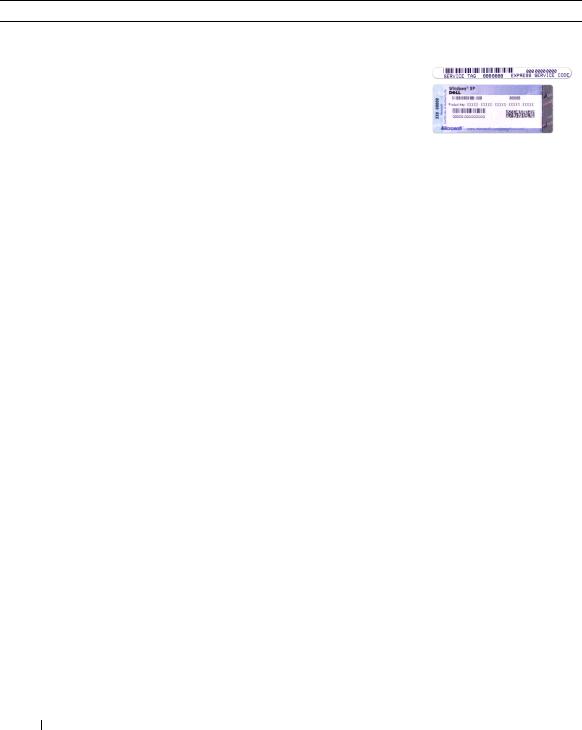
w w w . d e l l . c o m | s u p p o r t . d e l l . c o m
What Are You Looking For?
•Service Tag and Express Service Code
•Microsoft Windows License Label
Find It Here
Service Tag and Microsoft Windows License
These labels are located on the bottom of your computer.
• Use the Service Tag to identify your computer when you use support.dell.com or contact technical support.
•Enter the Express Service Code to direct your call when contacting technical support.
10 Finding Information

What Are You Looking For? |
Find It Here |
|
|
• Solutions — Troubleshooting hints and tips, articles |
Dell Support Website — support.dell.com |
from technicians, online courses, frequently asked |
NOTE: Select your region to view the appropriate support |
questions |
site. |
• Community — Online discussion with other Dell |
NOTE: Corporate, government, and education customers |
customers |
can also use the customized Dell Premier Support website |
• Upgrades — Upgrade information for components, such |
at premier.support.dell.com. The website may not be |
as memory, the hard drive, and the operating system |
available in all regions. |
• Customer Care — Contact information, service call and |
|
order status, warranty, and repair information |
|
• Service and support — Service call status and support |
|
history, service contract, online discussions with |
|
technical support |
|
• Reference — Computer documentation, details on my |
|
computer configuration, product specifications, and |
|
white papers |
|
• Downloads — Certified drivers, patches, and software |
|
updates |
|
• Notebook System Software (NSS) — If you reinstall the |
|
operating system for your computer, you should also |
|
reinstall the NSS utility. NSS provides critical updates |
|
for your operating system and support for Dell™ |
|
3.5-inch USB floppy drives, Intel® Pentium® M |
|
processors, optical drives, and USB devices. NSS is |
|
necessary for correct operation of your Dell computer. |
|
The software automatically detects your computer and |
|
operating system and installs the updates appropriate |
|
for your configuration. |
|
To download Notebook System Software: |
|
1 Go to support.dell.com and click Downloads. |
|
2 Enter your Service Tag or product model. |
|
3 In the Download Category drop-down menu, click All. |
|
4 Select the operating system and operating system |
|
language for your computer, and click Submit. |
|
5 Under Select a Device, scroll to System and |
|
Configuration Utilities, and click Dell Notebook |
|
System Software. |
|
Finding Information |
11 |

w w w . d e l l . c o m | s u p p o r t . d e l l . c o m
What Are You Looking For? |
Find It Here |
|
|
|
|
• How to use Windows XP |
Windows Help and Support Center |
|
• Documentation for my computer |
1 |
Click the Start button and click Help and Support. |
• Documentation for devices (such as a modem) |
2 |
Type a word or phrase that describes your problem and |
|
|
click the arrow icon. |
|
3 |
Click the topic that describes your problem. |
|
4 |
Follow the instructions on the screen. |
|
|
|
12 Finding Information

About Your Computer
Front View
 display latch release
display latch release
 display
display
hard drive and keyboard status lights
power button
keyboard
touch pad
 hard drive
hard drive
touch pad buttons 
device status lights 
speakers
DISPLAY LATCH RELEASE — Press this button to release the display latch and open the display.
DISPLAY — For information on adjusting your display, see "Display Functions" on page 42.
POWER BUTTON — Press the power button to turn on the computer or to enter or exit a power management mode.
NOTICE: To avoid losing data, use the Start menu to shut down your computer instead of pressing the power button.
SPEAKERS — To adjust the volume of the integrated speakers, press the volume-control key combinations. For more information, see page 43.
About Your Computer |
13 |
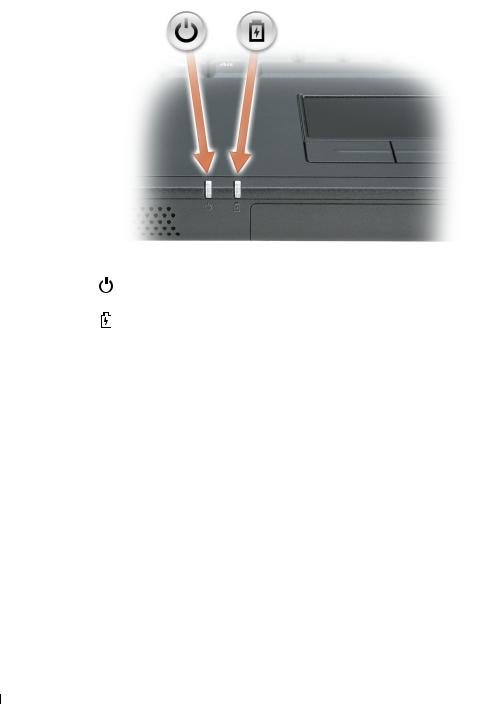
w w w . d e l l . c o m | s u p p o r t . d e l l . c o m
DEVICE STATUS LIGHTS
Turns on when you turn on the computer or pulses when the computer is in a power management mode.
Turns on steadily when the battery is being charged or flashes when the battery charge is low.
If the computer is connected to an electrical outlet, the  light operates as follows:
light operates as follows:
–Solid green: The battery is charging.
–Off: The battery is adequately charged, the computer is turned off, or no battery is installed.
–Rapidly flashing green: An error has occurred regarding the battery.
If the computer is running on a battery, the  light operates as follows:
light operates as follows:
–Off: The battery is discharging normally with use.
–Flashing amber: The battery charge is low.
TOUCH PAD AND TOUCH PAD BUTTONS — Touch pad and touch pad buttons provide the functionality of a mouse. See page 44 for more information.
KEYBOARD — The keyboard includes a numeric keypad as well as the Microsoft® Windows® logo key. For information on supported key combinations, see page 42.
14 About Your Computer

HARD DRIVE AND KEYBOARD STATUS LIGHTS
The green lights located above the keyboard indicate the following:
Turns on when the computer reads or writes data.
NOTICE: To avoid loss of data, never turn off the computer while the light is flashing.
9 |
Turns on when the numeric keypad is enabled. |
A
Turns on when the caps lock function is enabled.
Turns on when the scroll lock function is enabled.
About Your Computer |
15 |
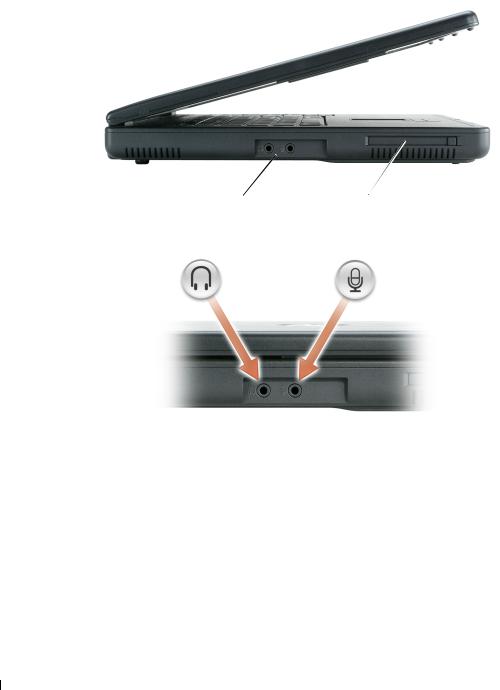
w w w . d e l l . c o m | s u p p o r t . d e l l . c o m
Left Side View
audio connectors |
PC Card slot |
AUDIO CONNECTORS
Attach headphones or speakers to the  connector.
connector.
Attach record/playback devices, such as cassette players
CD players, and microphones to the  connector.
connector.
PC CARD SLOT — Supports one PC Card, such as a modem, wireless card, or network adapter. For more information, see "Using PC Cards" on page 45.
16 About Your Computer
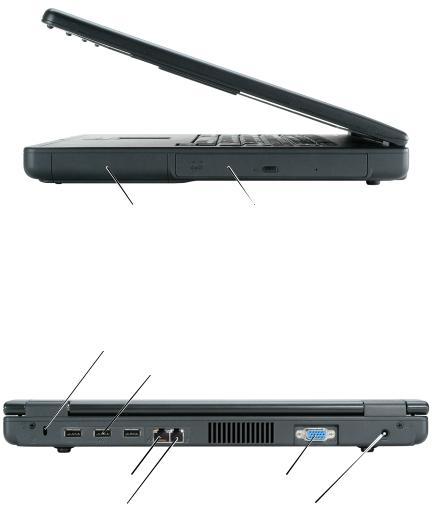
Right Side View
battery |
CD or DVD drive |
BATTERY/BATTERY BAY — When a battery is installed, you can use the computer without connecting the computer to an electrical outlet. See "Using a Battery" on page 27.
CD OR DVD DRIVE BAY — Accommodates a CD drive or DVD drive.
Back View
 security cable slot
security cable slot
 USB connectors (3)
USB connectors (3)
network connector (RJ-45) |
video connector |
modem connector (RJ-11) |
AC adapter connector |
About Your Computer |
17 |
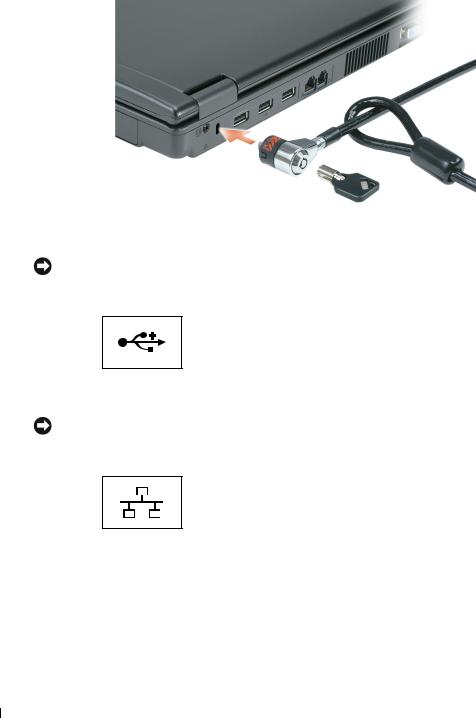
w w w . d e l l . c o m | s u p p o r t . d e l l . c o m
SECURITY CABLE SLOT — Lets you attach a commercially available antitheft device to the computer. For more information, see the instructions included with the device.
NOTICE: Before you buy an antitheft device, ensure that it will work with the security cable slot.
USB CONNECTORS
Connects USB 2.0 compliant devices, such as a mouse, keyboard, or printer.
NETWORK CONNECTOR (RJ-45)
NOTICE: The network connector is slightly larger than the modem connector. To avoid damaging the computer, do not plug a telephone line into the network connector.
Connects the computer to a network. The lights next to the connector indicate activity for both wired and wireless network communications.
For information on using the network adapter, see the online network-adapter documentation supplied with your computer.
18 About Your Computer
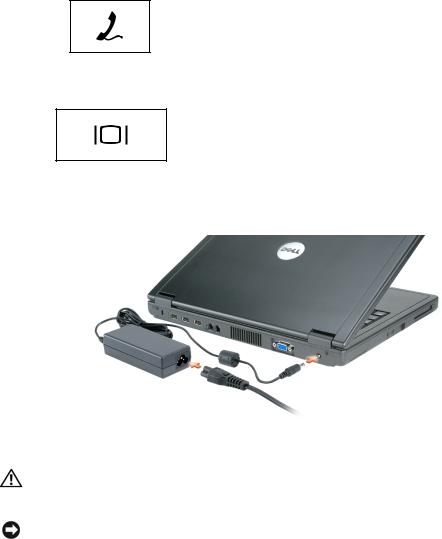
MODEM CONNECTOR (RJ-11)
Connects the telephone line to the modem connector.
For information on using the modem, see the online modem documentation supplied with your computer.
VIDEO CONNECTOR
Connects an external monitor.
AC ADAPTER CONNECTOR — Connects the AC adapter so that you can run the computer on AC power instead of battery power.
The AC adapter converts AC power to the DC power required by the computer. You can connect the AC adapter with your computer turned either on or off.
CAUTION: The AC adapter works with electrical outlets worldwide. However, power connectors and power strips vary among countries. Using an incompatible cable or improperly connecting the cable to the power strip or electrical outlet may cause fire or equipment damage.
NOTICE: When you disconnect the AC adapter cable from the computer, grasp the connector, not the cable itself, and pull firmly but gently to avoid damaging the cable.
About Your Computer |
19 |
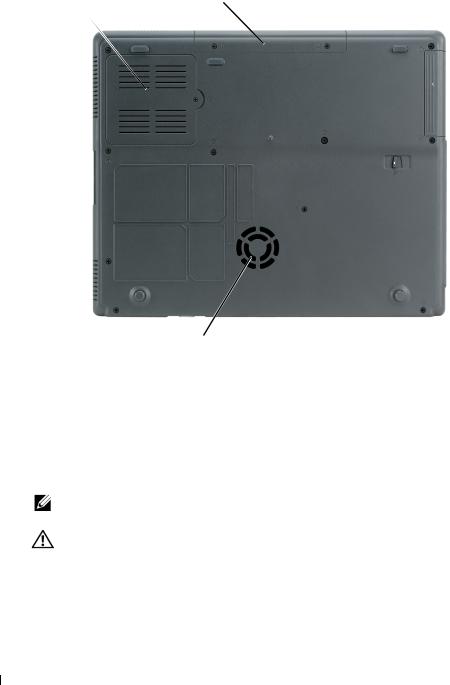
w w w . d e l l . c o m | s u p p o r t . d e l l . c o m
Bottom View
memory module |
hard drive |
cover
 battery
battery
 battery-bay latch release
battery-bay latch release
fan
MEMORY MODULE COVER — Covers the compartment that contains the memory module(s).
HARD DRIVE — Stores software and data.
BATTERY/BATTERY BAY — When a battery is installed, you can use the computer without connecting the computer to an electrical outlet. See "Using a Battery" on page 27.
BATTERY-BAY LATCH RELEAS — Releases the battery.
FAN — The computer uses an internal fan to create airflow through the vents, which prevents the computer from overheating.
NOTE: The computer turns on the fan when the computer gets hot. Fan noise is normal and does not indicate a problem with the fans or the computer.
CAUTION: Do not block, push objects into, or allow dust to accumulate in the air vents. Do not store your computer in a low-airflow environment, such as a closed briefcase, while it is running. Restricting the airflow can damage the computer or cause a fire.
20 About Your Computer

Setting Up Your Computer
Connecting to the Internet
NOTE: ISPs and ISP offerings vary by country.
To connect to the Internet, you need a modem or network connection and an Internet service provider (ISP). Your ISP will offer one or more of the following Internet connection options:
•Dial-up connections that provide Internet access through a telephone line. Dial-up connections are considerably slower than DSL and cable modem connections.
•DSL connections that provide high-speed Internet access through your existing telephone line. With a DSL connection, you can access the Internet and use your telephone on the same line simultaneously.
•Cable modem connections that provide high-speed Internet access through your local cable TV line.
If you are using a dial-up connection, connect a telephone line to the modem connector on your computer and to the telephone wall jack before you set up your Internet connection. If you are using a DSL or cable modem connection, contact your ISP for setup instructions.
Setting Up Your Internet Connection
To set up an Internet connection with a provided ISP desktop shortcut:
1Save and close any open files, and exit any open programs.
2Double-click the ISP icon on the Microsoft® Windows® desktop.
3Follow the instructions on the screen to complete the setup.
If you do not have an ISP icon on your desktop or if you want to set up an Internet connection with a different ISP:
1Save and close any open files, and exit any open programs.
2Click the Start button and click Internet Explorer. The New Connection Wizard appears.
3Click Connect to the Internet.
4In the next window, click the appropriate option:
•If you do not have an ISP and want to select one, click Choose from a list of Internet service providers (ISPs).
Setting Up Your Computer |
21 |

w w w . d e l l . c o m | s u p p o r t . d e l l . c o m
•If you have already obtained setup information from your ISP but you did not receive a setup CD, click Set up my connection manually.
•If you have a CD, click Use the CD I got from an ISP.
5Click Next.
If you selected Set up my connection manually, continue to step 6. Otherwise, follow the instructions on the screen to complete the setup.
NOTE: If you do not know which type of connection to select, contact your ISP.
6Click the appropriate option under How do you want to connect to the Internet?, and then click Next.
7Use the setup information provided by your ISP to complete the setup.
If you are having problems connecting to the Internet, see "E-Mail, Modem, and Internet Problems" on page 55. If you cannot connect to the Internet but have successfully connected in the past, the ISP might have a service outage. Contact your ISP to check the service status, or try connecting again later.
Transferring Information to a New Computer
The Microsoft® Windows® XP operating system provides a Files and Settings Transfer wizard to move data from the source computer to the new computer. You can move data such as:
•E-mails
•Toolbar settings
•Window sizes
•Internet bookmarks
You can transfer the data to the new computer over a network or serial connection, or you can store it on a removable medium, such as a writable floppy disk or CD, for transfer to the new computer.
NOTE: You can transfer information from the old computer to the new computer by directly connecting a serial cable to the input/output (I/O) ports of the two computers. To transfer data over a serial connection, you must access the Network Connections utility from the Control Panel and perform additional configuration steps, such as setting up an advanced connection and designating the host computer and the guest computer.
For instructions on setting up a direct cable connection between two computers, see Microsoft Knowledge Base Article #305621, titled How to Set Up a Direct Cable Connection Between Two Computers in Windows XP.
For transferring information to a new computer, you must run the Files and Settings Transfer wizard. You can create a Wizard disk with the Transfer Wizard utility or use the Operating System CD for this process.
22 Setting Up Your Computer
Running the Files and Settings Transfer Wizard Without the Operating System CD
To run the Files and Settings Transfer Wizard without the Operating System CD, you must create a Wizard disk that will allow you to create a backup image file to removable media.
To create a Wizard disk, use your new computer with Windows XP and perform the following steps:
1Click the Start button.
2Click Files and Settings Transfer Wizard.
3When the Files and Settings Transfer Wizard welcome screen appears, click Next.
4On the Which computer is this? screen, click New Computer and click Next.
5On the Do you have a Windows XP CD? screen, click I want to create a Wizard Disk in the following drive: and click Next.
6Insert the removable media, such as a floppy disk or CD, and click OK.
7When the disk creation completes and the Now go to your old computer message appears, do not click Next.
8Go to the old computer.
To copy data from the old computer:
1On the old computer, insert the removable Wizard Disk.
2Click the Start button and click Run.
3In the Open field on the Run window, type in a:\fastwiz and click OK.
4On the Files and Settings Transfer Wizard welcome screen, click Next.
5On the Which computer is this? screen, click Old Computer and click Next.
6On the Select a transfer method screen, click the transfer method you prefer.
7On the What do you want to transfer? screen, select the items you want to transfer and click
Next.
After the information has been copied, the Completing the Collection Phase screen appears.
8Click Finish.
To transfer data to the new computer:
1On the Now go to your old computer screen on the new computer, click Next.
2On the Where are the files and settings? screen, select the method you chose for transferring your settings and files and click Next. Follow the instructions on the screen.
The wizard reads the collected files and settings and applies them to your new computer. When all of the settings and files have been applied, the Finished screen appears.
Setting Up Your Computer |
23 |

w w w . d e l l . c o m | s u p p o r t . d e l l . c o m
3 Click Finished and restart the new computer.
NOTE: For more information about this procedure, search dell.support.com for document #PA1089586 (How Do I Transfer Files From My Old Computer to My New Dell Computer using the Microsoft® Windows® XP Operating System?).
Running the Files and Settings Transfer Wizard With the Operating System CD
NOTE: This procedure requires the Operating System CD. This CD is optional and may not be included with all computers.
To prepare the new computer for the file transfer:
1Start the Files and Settings Transfer Wizard.
2When the Files and Settings Transfer Wizard welcome screen appears, click Next.
3On the Which computer is this? screen, click New Computer and click Next.
4On the Do you have a Windows XP CD? screen, click I will use the wizard from the Windows XP CD and click Next.
5When the Now go to your old computer screen appears, go to your old or source computer. Do not click Next at this time.
To copy data from the old computer:
1On the old computer, insert the Windows XP Operating System CD.
2On the Welcome to Microsoft Windows XP screen, click Perform additional tasks.
3Under What do you want to do?, click Transfer files and settings.
4On the Files and Settings Transfer Wizard welcome screen, click Next.
5On the Which computer is this? screen, click Old Computer and click Next.
6On the Select a transfer method screen, click the transfer method you prefer.
7On the What do you want to transfer? screen, select the items you want to transfer and click
Next.
After the information has been copied, the Completing the Collection Phase screen appears.
8Click Finish.
To transfer data to the new computer:
1On the Now go to your old computer screen on the new computer, click Next.
2On the Where are the files and settings? screen, select the method you chose for transferring your settings and files and click Next.
The wizard reads the collected files and settings and applies them to your new computer. When all of the settings and files have been applied, the Finished screen appears.
3Click Finished and restart the new computer.
24 Setting Up Your Computer
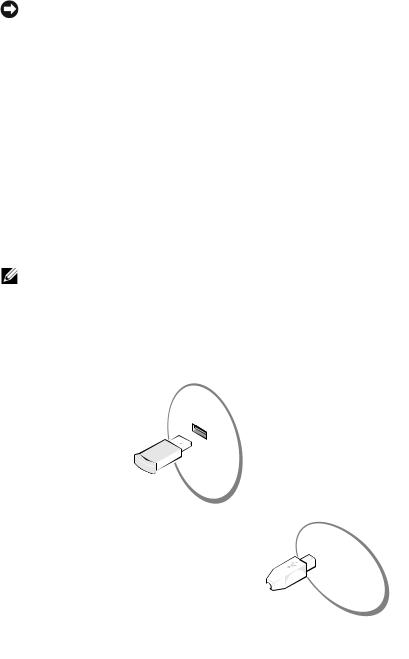
Setting Up a Printer
NOTICE: Complete the operating system setup before you connect a printer to the computer.
See the documentation that came with the printer for setup information, including how to:
•Obtain and install updated drivers.
•Connect the printer to the computer.
•Load paper and install the toner or ink cartridge.
•Consult the printer Owner's Manual for technical assistance, or call the printer manufacturer.
Printer Cable
Your printer connects to your computer with a USB cable. Your printer may not come with a printer cable, so if you purchase a cable separately, ensure that it is compatible with your printer. If you purchased a printer cable at the same time you purchased your computer, the cable may arrive in the computer box.
Connecting a USB Printer
NOTE: You can connect USB devices while the computer is turned on.
1Complete the operating system setup if you have not already done so.
2Attach the USB printer cable to the USB connectors on the computer and the printer. The USB connectors fit only one way.
 USB connector on computer
USB connector on computer
 USB connector
USB connector  USB printer on printer cable
USB printer on printer cable 
Setting Up Your Computer |
25 |

w w w . d e l l . c o m | s u p p o r t . d e l l . c o m
3Turn on the printer and then turn on the computer. If the Add New Hardware Wizard window appears, click Cancel.
4Install the printer driver if necessary. See the documentation that came with your printer.
Power Protection Devices
Several devices are available to protect against power fluctuations and failures:
•Surge protectors
•Line conditioners
•Uninterruptible power supplies (UPS)
Surge Protectors
Surge protectors and power strips equipped with surge protection help to prevent damage to your computer from voltage spikes that can occur during electrical storms or following power interruptions. The level of protection is usually commensurate with the cost of the surge protector. Some surge protector manufacturers include warranty coverage for certain types of damage. Carefully read the device warranty when choosing a surge protector. A device with a higher joule rating offers more protection. Compare joule ratings to determine the relative effectiveness of different devices.
NOTICE: Most surge protectors do not protect against power fluctuations or power interruptions caused by nearby lightning strikes. When lightning occurs in your area, disconnect the telephone line from the telephone wall jack and disconnect your computer from the electrical outlet.
Many surge protectors have a telephone jack for modem protection. See the surge protector documentation for modem connection instructions.
NOTICE: Not all surge protectors offer network adapter protection. Disconnect the network cable from the network wall jack during electrical storms.
Line Conditioners
NOTICE: Line conditioners do not protect against power interruptions.
Line conditioners are designed to maintain AC voltage at a fairly constant level.
Uninterruptible Power Supplies
NOTICE: Loss of power while data is being saved to the hard drive may result in data loss or file damage.
NOTE: To ensure maximum battery operating time, connect only your computer to a UPS. Connect other devices, such as a printer, to a separate power strip that provides surge protection.
A UPS protects against power fluctuations and interruptions. UPS devices contain a battery that provides temporary power to connected devices when AC power is interrupted. The battery charges while AC power is available. See the UPS manufacturer documentation for information on battery operating time and to ensure that the device is approved by Underwriters Laboratories (UL).
26 Setting Up Your Computer

Using a Battery
Battery Performance
CAUTION: Before you begin any of the procedures in this section, follow the safety instructions located in the Product Information Guide.
NOTE: For information about the Dell warranty for your computer, see the Product Information Guide or separate paper warranty document that shipped with your computer.
For optimal computer performance and to help preserve BIOS settings, operate your Dell™ portable computer with the main battery installed at all times. Use a battery to run the computer when it is not connected to an electrical outlet. One battery is supplied as standard equipment in the battery bay.
NOTE: Battery capacity (the time it can hold a charge) decreases over time. Depending on how often the battery is used and the conditions under which it is used, you may need to purchase a new battery during the life of your computer.
•Battery operating time varies depending on operating conditions. Operating time is significantly reduced when you perform operations including, but not limited to, the following:
•Using optical drives, such as DVD or CD drives
•Using wireless communications devices, PC Cards, or USB devices
•Using high-brightness display settings, 3D screen savers, or other power-intensive programs such as 3D games
•Running the computer in maximum performance mode
NOTE: It is recommended that you connect your computer to an electrical outlet when writing to a CD or DVD.
You can set power management options to alert you when the battery charge is low.
CAUTION: Using an incompatible battery may increase the risk of fire or explosion. Replace the battery only with a compatible battery purchased from Dell. The lithium-ion battery is designed to work with your Dell computer. Do not use a battery from other computers with your computer.
CAUTION: Do not dispose of batteries with household waste. When your battery no longer holds a charge, call your local waste disposal or environmental agency for advice on disposing of a lithium-ion or Nickel metal-hydride battery. See "Battery Disposal" in the Product Information Guide.
Using a Battery |
27 |
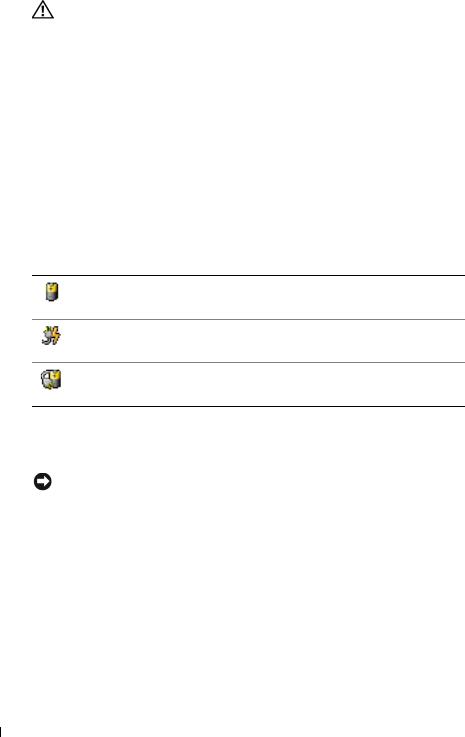
w w w . d e l l . c o m | s u p p o r t . d e l l . c o m
CAUTION: Misuse of the battery may increase the risk of fire or chemical burn. Do not puncture, incinerate, disassemble, or expose the battery to temperatures above 65°C (149°F). Keep the battery away from children. Handle damaged or leaking batteries with extreme care. Damaged batteries may leak and cause personal injury or equipment damage.
Checking the Battery Charge
The Dell QuickSet Battery Meter and the low-battery warning provide information on the battery charge.
Dell QuickSet Battery Meter
If Dell QuickSet is installed, press <Fn><F3> to display the QuickSet Battery Meter.
The Battery Meter window displays status, charge level, and charge completion time for the battery in your computer.
The following icons appear in the Battery Meter window:
•The computer is running on battery power.
•The battery is discharging or idle.
•The computer is connected to an electrical outlet and running on AC power.
•The battery is charging.
•The computer is connected to an electrical outlet and running on AC power.
•The battery is discharging, idle, or charging.
For more information about QuickSet, right-click the  icon in the taskbar, and click Help.
icon in the taskbar, and click Help.
Low-Battery Warning
NOTICE: To avoid losing or corrupting data, save your work immediately after a low-battery warning. Then connect the computer to an electrical outlet. If the battery runs completely out of power, hibernate mode begins automatically.
A low-battery warning occurs when the battery charge is approximately 90 percent depleted. The computer beeps once, indicating that minimal battery operating time remains. During that time, the speaker beeps periodically. The computer enters hibernate mode when the battery charge is at a critically low level. For more information about low-battery alarms, see "Power Management" on page 31.
28 Using a Battery

Charging the Battery
NOTE: The AC adapter charges a completely discharged battery in approximately 2 hours (for nickelmetal hydride batteries [NiMH], and 2.5 hours for lithium-ion [Li-ion] batteries) with the computer turned off. Charge time is longer with the computer turned on. You can leave the battery in the computer as long as you like. The battery’s internal circuitry prevents the battery from overcharging.
When you connect the computer to an electrical outlet or install a battery while the computer is connected to an electrical outlet, the computer checks the battery charge and temperature. If necessary, the AC adapter then charges the battery and maintains the battery charge.
If the battery is hot from being used in your computer or being in a hot environment, the battery may not charge when you connect the computer to an electrical outlet.
The battery is too hot to start charging if the  light flashes alternately green and orange. Disconnect the computer from the electrical outlet and allow the computer and the battery to cool to room temperature. Then connect the computer to an electrical outlet to continue charging the battery.
light flashes alternately green and orange. Disconnect the computer from the electrical outlet and allow the computer and the battery to cool to room temperature. Then connect the computer to an electrical outlet to continue charging the battery.
For more information about resolving problems with a battery, see "Power Problems" on page 62.
Recalibrating a Battery
If your system is configured with a nickel-metal hydride (NiMH) battery, you can recalibrate the battery by running the Battery Recalibration software. Recalibrating the battery ensures that the Power Meter indicator is accurate.
Recalibrate your NiMh battery when one of the following occurs:
•A message appears, prompting you to recalibrate your battery.
•The typical battery operating time decreases.
When you recalibrate your NiMH battery, do not remove the battery. Allow several hours for the procedure to complete.
Recalibrating a Battery When the Recalibrating Message Appears
NOTE: A battery recalibration message will appear only during booting.
If your computer displays a message that prompts you to recalibrate your battery:
1Turn off the computer by pressing and holding the power button until all device status-light activity ceases (approximately 5 seconds).
2Connect the computer to an electrical outlet and turn it back on.
The battery recalibration message should appear on the screen immediately following the Dell logo.
3To skip the battery recalibration process and continue the system boot, press <ESC>.
Using a Battery |
29 |

m |
4 |
To start the Battery Recalibration procedure, press <F1>. |
|
l . c o |
|
The battery recalibration begins and the AC adapter charges the battery until the battery |
|
d e l |
|
gauge on the battery information screen states 100% charged. |
|
o r t . |
|
• The Battery Recalibration Process screen appears showing the functions (Charge or |
|
p p |
|
Discharge) on the left of the screen and the Battery Info charge status on the right of the |
|
s u |
|
screen. |
|
| |
|
|
|
|
|
|
|
m |
|
• The AC adapter begins charging the battery. The Charge Battery to Full option is |
|
. c o |
|
highlighted on the left of the screen. The battery charge information is displayed on the |
|
e l l |
|
right of the screen. |
|
w . d |
|
• The AC adapter charges the battery until the battery gauge states 100% charged. The |
|
w |
|
battery status light turns off after the battery is fully charged. |
|
w |
|
|
|
|
|
NOTE: A message prompting you to remove the AC adapter appears when the battery is fully charged. |
|
|
5 When prompted, disconnect the AC adapter. |
|
|
|
|
The battery discharges until the battery gauge states 0% charged. The Discharge Battery to |
|
|
|
Empty option is highlighted on the left of the screen. When the battery is completely |
|
|
|
discharged, the computer automatically turns off. |
|
|
6 Connect the AC adapter to your computer. |
|
|
|
7 |
Allow the AC adapter to charge the battery until the battery status light |
turns off. |
NOTE: You can operate your computer while the battery is charging. However, do not operate your computer using battery power until the battery is fully charged.
Recalibrating a Battery Through the System Setup Utility
1 Connect the computer to an electrical outlet.
2 Turn on (or restart) the computer.
3 When the Dell Logo appears, press <F2> immediately. If you wait too long and the logo for the Microsoft® Windows® operating system appears, continue to wait until you see the Windows desktop. Then shut down your computer and try again.
NOTE: For information about a specific item on a System Setup screen highlight the item and see the Help area on the screen.
4 Using the down-arrow key, select Battery Info.
• The Battery Info charge status is displayed on the right side of the screen.
• The AC adapter charges the battery until the battery gauge states 100% charged.
• The battery status light  turns off after the battery is fully charged.
turns off after the battery is fully charged.
5 Ensure that the battery status light is off.
30 Using a Battery
